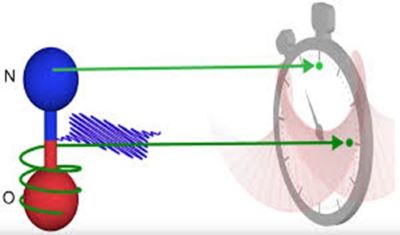Context-
Researchers are revisiting a phenomenon that has been known for over a century, breathing new life into the study of the photoelectric effect. This renewed focus is paving the way for breakthroughs in the imaging of proteins and viruses, a deeper understanding of biochemical reactions, and the development of materials for next-generation electronics.
The Historical Significance of the Photoelectric Effect
● In the early 20th century, physicists observed that when a metal is irradiated with light, it emits electrons. Albert Einstein explained this phenomenon in 1905 by proposing that light consists of particles called photons. He showed that an electron is emitted if a photon has more energy than a certain threshold, depending on the frequency of the light rather than its intensity. This explanation earned Einstein his sole Nobel Prize in Physics and laid the foundation for the development of solar cells.
● Solar cells operate on this principle: when sunlight hits these specially engineered materials, electrons are knocked out by the incoming photons, creating an electric current as these electrons flow through a wire. Understanding the photoelectric effect more thoroughly could lead to more efficient solar cells and enhance our grasp of the fundamental physics involved, providing insights into subatomic features that are difficult to explore with other methods.
● In the latter half of the 20th century, advancements in electronics and optics enabled physicists to study the photoelectric effect with unprecedented precision. A key tool in this research has been the use of ultrashort light pulses. Just last year, three physicists were awarded the Nobel Prize for their contributions to the development of these pulses, which allow for highly precise observations.
● To understand the significance of these pulses, consider the analogy of capturing an image with a camera. The clarity of the image depends on the exposure time: to capture the wings of a bird in flight without blur, the exposure time must be shorter than the time it takes for the wing to move. Similarly, ultrashort pulses of light allow physicists to illuminate atoms or molecules while capturing short-lived events.
● Early studies used femtosecond pulses (10⁻¹⁵ seconds) to investigate heavy atomic nuclei. More recently, the development of attosecond pulses (10⁻¹⁸ seconds) has enabled scientists to study even faster processes, such as the movement of electrons around atoms.
Photoionisation Delay and Its Significance
● A major focus of recent studies is the photoionisation delay — the time between a reference event and when an electron is emitted. This delay provides crucial insights into the electronic structure of matter. It arises from the interactions between electrons and their environment, often represented by a potential related to the molecule’s structure. Understanding these delays can help physicists develop theoretical models for molecules, potentially allowing them to design materials with specific electronic properties.
● For instance, in 2010, Ferenc Krausz (one of the 2023 Nobel laureates) and his team discovered a 20-attosecond delay between the emissions of two electrons from closely spaced energy levels in a neon atom. More recently, researchers from the Autonomous University of Madrid challenged the assumption that an atom’s nucleus is too slow to significantly affect photoionisation. They found that the nucleus’s movement, in just a few attoseconds, could substantially increase the photoionisation delay of electrons in a hydrogen molecule (H₂⁺).
● In a more recent study published in August 2024, researchers from the SLAC National Accelerator Laboratory in California reported unexpectedly large delays in the photoemission of electrons from oxygen and nitrogen atoms in nitric oxide (NO) molecules. They built a device capable of producing photons with enough energy to knock out core electrons (non-valence electrons that do not participate in chemical reactions) in an attosecond-physics setup. This was the first measurement of photoemission delay in the X-ray regime, extending beyond previous studies that focused on the ultraviolet regime.
● The SLAC researchers found that core electrons in oxygen were emitted up to 700 attoseconds after those in nitrogen, rather than at the same time. The delay was attributed to multiple factors, including shape resonance, where an electron’s energy and wavelength resonate with the potential barrier of the molecule, causing the electron to be ‘trapped’. Additionally, interactions with other electrons, such as collisions with Auger-Meitner electrons, further delayed photoemission.
● These findings echo those of a 2016 study that examined photoionisation delays in water and nitrous oxide (N₂O) molecules. The study found that delays in N₂O reached up to 160 attoseconds, significantly longer than those in water. The researchers attributed these delays to shape resonance, which traps electrons within the molecule’s electric and magnetic fields.

Implications for Future Research and Applications
The recent discoveries have significant implications for various fields, including materials science and biochemistry.
Advancing X-ray-Matter Interactions
The new findings enhance our understanding of X-ray interactions with matter, which is crucial for applications like protein and virus imaging at facilities such as SLAC. By improving the ability to measure photoemission delays, researchers are developing new methods to probe electron correlations in real-world systems.
Potential Applications in Electronics and Biochemistry
Understanding electron correlation is vital for defining and tuning the properties of materials. Advances in this area could lead to better control over electronic behaviors at the molecular level, opening up possibilities for designing next-generation electronics and gaining deeper insights into biochemical reactions.
Conclusion
By exploring these fundamental processes, researchers are not only deepening our understanding of the universe but also laying the groundwork for practical applications that may not yet be fully imagined. The study of the photoelectric effect continues to yield insights that could transform future technologies in ways that mirror the historical impact of early quantum physics research.
|
Probable Questions for UPSC Mains Exam- 1. How have recent advancements in ultrashort light pulses contributed to our understanding of the photoelectric effect, and what significance do photoionisation delays hold in studying the electronic structure of matter? (10 marks, 150 words) 2. What were the key findings of the SLAC National Accelerator Laboratory's recent study on photoemission delays in nitric oxide molecules, and how do these findings impact future applications in materials science and biochemistry? (15 Marks, 250 words) |
Source- The Hindu







